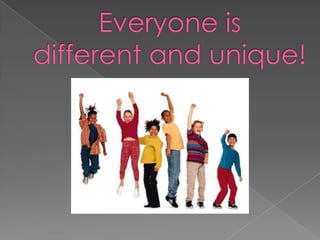
Everyone Is Different PowerPoint
- 1. Everyone is different and unique!
- 2. What is Autism? Autism is a developmental disability. This means they experience the world differently than you do. They may play differently, communicate differently and even have different interests. But that’s OK!! Because our friend with autism still does many things just like you: sleep, eat, go to the doctor, go to school, etc. Autism is NOT like a cold- it does not just go away.
- 3. What makes everyone different? *Some children develop differently than others and their brains function differently. *Some kids are mildly affected by their brain working differently and aren’t that much different from you! *Other kids may need a lot of help from you, their teachers and parents.
- 4. But WHY are we all different? ? *Some doctors think the reason your brain might be different from your friend with autism could be a link between: genetics and a medical problem. *Everyone is made up of many different genes and genes make up your DNA. Someone with autism might have some genes that may affect their brain development. *While some doctors think it could be related to genes and medical conditions, other think it could also be due to toxins in the environment. So there isn’t one answer that can explain why your friend or someone you know has autism, but there are 3 possibilities: genes, medical conditions and environmental toxins ?
- 5. I know why we are all different, but is there a cure for my friend with autism? *The answer to that question is No, there is no cure for Autism *With the help of doctors, teachers, family, friends and YOU, the person with autism can lead a normal life! *It is important to be very kind and understanding of our friends with autism. Wanting to learn more about our friend with autism is a GREAT first step
- 8. What is an environmental toxin?
- 9. Can you “catch” an autism spectrum disorder from environmental toxins?
- 10. Can I “catch” autism from my friend with autism?
- 11. Just because I am a boy, will I have autism and my friend that is a girl wont?
- 12. What are the five types of autism spectrum disorders?
